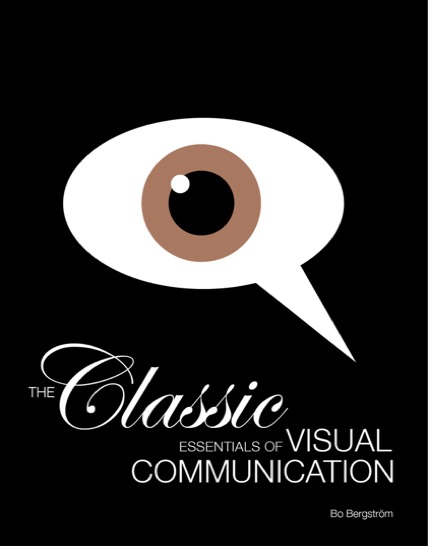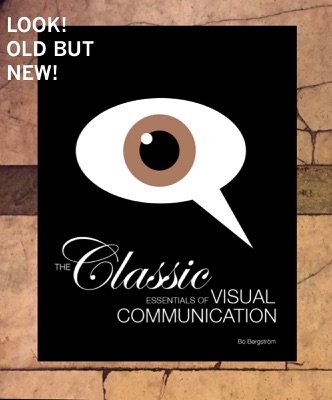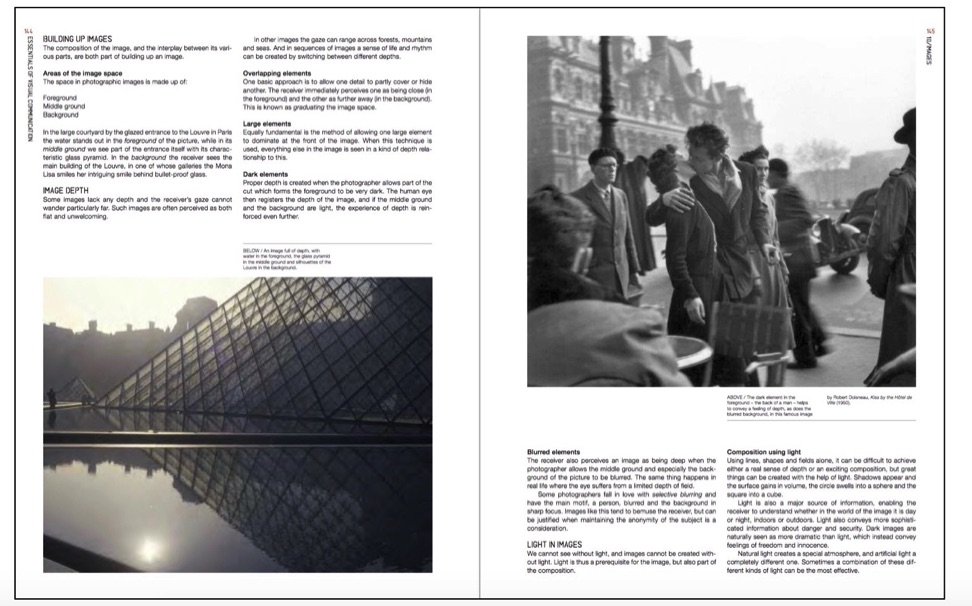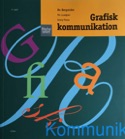
Visual Communication
Suddenly it happens. Luck is often involved when a crucial change occurs. And then it goes fast. Hang on here.
A Swedish-speaking designer at the Financial Times in London becomes 2005 interested in “Effektiv visual Kommunikation”. He tells a publisher in the same city. The publisher translates and publishes the book “Essentials of Visual Communication”. It is first printed in English (2008) but then also in Spanish, Portuguese, Polish, Hungarian, Latvian, Czech, Albanian and Chinese.
The book makes its triumphal over the world. Read the reviews. The publisher in London is pleased.
The rights are now transferred to our company, Water Publishing, and we decide to publish the book as an e-book. First of all, according to the origin, because image and text materials still feel vital and exciting "It's so beautiful," many say. "Stately". "Nice pictures". Although the content has a few years on the neck, it is filled to the top with "eternal truths", which makes it valid yet today. Hence the title "The Classic". Old but new.
The reviews applies to the paper edition of “Essentials of Visual Communication”. We look forward to the same appealing words for "The Classic".
REVIEWS
The book Essentials of Visual Communication focuses on Visual Communication - it's context as well as it's social impact. It discusses various aspects of visual communication in an up-to-date manner, including good images and examples, it focuses on modern media as well as including traditional methods and practices.
The author Bo Bergstrom has experience as a creative director in advertising agencies in Sweden and is a co-owner of one agency, he has received many prestigious awards in communication and design. He translates his own ideas and experiences throughout the book in an interesting way where his views are an extension of his experience on the subjects and are not meant to opinionate the reader.
He begins each chapter with a short introduction using personal experience to draw you into understanding the chapter, he then goes onto explain jargon and to give illustrations and examples of relevant design and film to aid the reader.
The style of writing is really good, it is almost like reading a novel as you want to continue reading chapter after chapter. The style of the book is clear and well designed, the images and examples are good quality and he includes some thought provoking anecdotes to keep you thinking about what you are reading.
The chapters are all interesting and range from basic design elements such as Typography and colour but also concentrates on the creative process and how messages are perceived by the audience. One chapter which particularly interested me was 'storytelling', I have heard this phrase often mentioned and have not really understood how this could be incorporated into Graphic Design but Bo Bergstrom gives you the components and thought processes behind story telling in Design.
I will definitely be buying this book as although aimed at students, it has some great points and practical advice which would be useful to a Designer at any point of their career.
Lisa Baines Graphic Design
Everything communicates. Certainly a cliché, but also the cornerstone for a whole range of professions in the media fields. This book is a very well crafted introduction to communication through news, advertising and profiling. It covers the full spectrum from storytelling and strategy to text, image, form, color and sound. Moreover, the author manages to treat a multitude of media channels – print, TV, radio, web, and so on – in a coherent way. I am expecting an increasing number of interaction designers to start collaborating with the media industry. This book introduces the language and craft skills of media professionals in an accessible and appetizing way, and thus should help the ixd/media collaboration off to a flying start.
Jonas Löwgren, Library Thing
This book really is an introduction to visual communication, with excellent quality, full of images and meaningful content.
L Cannis
We used this book as a supplement to an Advertising class I had. It was very easy to read and also interesting.
Stephanie A Dennis
The most apparent reason why Essentials of Visual Communication by Bo Bergstrom is selling all over the world, is that Professor Bergstrom is highly aware of the “shift of power” upon this generation. After discussing the elements and essentials involved in visual communication as presented in Bergstrom‘s text, students were able to view the world more critically when visiting museums, viewing television and film, working on computers, and (even) reading their textbooks. Their age of self-production and amateurism introduced in Bergstrom’s highly acclaimed text became relevant to my students as they took a high dive into film.
Essentials of Visual Communication stresses knowing the purpose of a message for a target audience and the text gives practical examples that indicate the importance in the details involved in choosing font, color, space, sound, position, and even paper used to achieve the chosen purpose. Students become quickly aware of the “hard work” involved in film and other creativity, but they also find the joy.
One student says, “I’d like to be a publisher” and another two students are interested in photography and one plans to be a journalist. Bo Bergstrom’s text inspired these college freshman with enough information to pursue this variety of interests. One student could see the importance of visuals in her chosen career of forensic science and another student could see associations of visual communication to her choice of the ambitious path to a Ph.D. in psychology. At least five other students plan to follow a filmmaking career.
Another student stated, “I plan to go into visual communication.” Her statement reflects the importance of visual communication that emerged at the American College of Norway in Moss, Norway throughout a course in visual communication using Bo Bergstrom‘s text Essentials of Visual Communication. A “shift in power” and a belief in creative self-development is a thread that runs through Bergstrom’s text making quite a few things possible for students of visual communication.
Adonica Schultz Aune, Ph.D.
I like a good introductory textbook but they are surprisingly hard to find – a book you can use with complete beginners that explains the basics, that doesn’t take risks, that illustrates everything it discusses. Bo Bergström’s Essentials of visual communication is just such a book, and if you accept that it is an introduction you will not be disappointed. As the author says in his foreword, it is ‘an aerial view over the whole communication process’. He believes in cooperation among communications professionals, and a close integration of strategy with creativity (if you’ve worked in a design agency where people in suits and people in t‐shirts sit in different rooms you will know what he means by this). His contribution is to explain at a very basic level, and in one book, how different communications specialists work – the way they work, their distinctive roles, how they work as teams, and how they develop ideas.
Few basic books on design attempt this – most being content just to show good work and list visual techniques. So we have chapters on how projects are created, and managed, how messages are planned, cultural influences and effects, as well as design basics such as typography, colour, paper, imagery and copywriting. The book is copiously illustrated with relevant and engaging examples – not just to showcase great work, but to explain the ideas in the book.
In summary, Essentials of visual communication is a comprehensive and useful introduction to graphic design. It has plenty of insight into design practice, and it would be ideal for a school or first‐year college student of graphic design, or perhaps someone working with professional designers, photographers, filmmakers and copywriters, who wants to know how they think and how they work.”
Rob Waller, Professor of Information Design at University of Reading
This book thoroughly describes all aspects of visual communication in a structured manner, making it a perfect choice for students studying for example multimedia design. It avoids becoming overwhelming by describing only essentials in each chapter. The layout of the book is beautiful in a simple and elegant way and all photo material seems carefully chosen. I have really enjoyed it!
Linda B Bertelsen
Essentials of Visual Communication provides an excellent introduction to the field. The table of contents is arranged under conceptual headings like “strategy,” “messages,” “text,” “colour” etc. making this book accessible to non-linear reading.
Bergström simplifies complex concepts in order to fulfil his mandate of providing the “essentials” of visual communication. For example, he pares down difficult ideas from Roland Barthes (e.g., anchorage and relay) and Charles Peirce (icon, index, symbol) and uses more approachable language when describing the terms.
The book’s stunning visual examples, drawn from advertising, art, photojournalism, and cultural artefacts, are generally spot on. Bergström chooses vibrant, politically-challenging images to prove his points. He also draws on commercial examples to reflect the popular culture angle the book takes; however, he always picks images that are multidimensional. Most offer ironic predicaments or exceptional aesthetic value. Overall, Essentials of Visual Communication is an excellent primer.
Isabel Pedersen, Associate Professor, Ryerson University, Toronto, Canada
”Aimed at students studying for a first degree,” reads the first line of the publisher’s description for this book. This is a disservice to the depth of the content - it is far more than a student text. While it would make good required reading for a course in visual communication/visual studies, I’d recommend it as supplementary reading for practising graphic designers, photographers, videographers and people in advertising brand-building or strategy.
Many people in these professions have studied one or two subsets of visual communication. This book presents a well-written overview of how all these branches of visual communication work (and work together.) The book fills in holes.
It is beautifully produced with current examples, mostly from Europe (it is published by a British publisher and thus is slanted toward the European market.) Unlike many books on visual studies, it comes across as a well-written, carefully considered and structured text with appropriate and current illustrations rather than a collection of images with explanatory text shoehorned in to fit.
“Design guy”
The composition market in the US seems to keep reprinting the same books under new titles every year, and I have stopped hoping for some new views on composition teaching coming from the big players in the publishing industry in this country.
Bergstrom’s book truly does not disappoint, and I’d seriously consider using it next time I teach visual rhetoric. Here’s why.
The way I see it, texts on visual communication typically fall into one of two categories:
- highly theoretical and sometimes inaccessible to undergraduates.
- books that are typically geared towards technical and scientific communication student and professionals and focus on the utilitarian practicalities of document and graphic design.
The attractive aspect of this book is the combination of accessibly discussed “larger issues” behind visual communication and practical steps for implementation of visual communication projects. A good portion of the book is devoted to what I’d call ways of conducting rhetorical analyses of visual texts, or critical reading of those texts. There is also a section on story telling with images, which is a very nice addition since more other texts are missing those types of discussions.
The second half of the book is devoted to practical issues and strategies: fonts, color schemes, interplay of media, and so on.
I was also pleasantly surprised to see the image of the fascinating Web Trend Subway Map, as well as the inclusion into the discussion for various forms and media of visual communication, from text and still image, to television and sound.
Overall, this is a very comprehensive text, one worth looking at if you teach or study visual persuasion and communication.
pz-writing
A book about the entire work in visual communication, message, design, image and interplay between text and picture. Written in an inspiring, pedagogical, experienced and personal voice. My students will love it and this book will in a crucial way help them to gain a career as successful communicators.
Per Lundgren, lecturer and researcher, Karlstad University, Sweden
Our market covers greater part of this world, and so does this book! The book covers A-Z on visual communication in a way which suits all markets and companies. Just from looking through the book briefly it is obvious this book will be used a lot, maybe even on a daily basis. Whatever you are looking for - this is the place where you will find it.
A C Emanuelsson, Trademark Manager, Inter IKEA Holding Services S.A.
The next one to talk about is Essentials of Visual Communication, by Bo Bergstrom, and put out by Laurence King. This book is really good. It covers how to get to great visual communication in your work. From storytelling to strategy and influences, this book explains how the process works and how to do this in practice. It also covers the basics, such as images and typography, but the depth is the real item here. I think students in the higher levels would really benefit from this book.
Mike Lenhart
One of the most comprehensive books on visual communication has now been published in English. “The Essentials of Visual Communication”, by Bo Bergström. Fotosidan (Photo page) has red it.
Bo Bergström, author, lecturer and creative director has written a handful of books on visual communication in Swedish. The latest book is however in English and published by prestigious Laurence King Publishing in London. The book deals with the whole communication chain of visual communication; photo, film, journalism, advertising, graphic design… simply all communication, which originate from text and image.
The great benefits by Bo Bergström’s earlier books have been his devoted and personal narration, the pedagogical and easy defined structure, with almost red-hot examples from our media consumption. This new book is no exception.
Besides from the informative and inspiring role the book offers, there is also a throughout driving force to enlighten and point out the responsibility we communication workers have. From a bird-eye-view Bergström lifts up currents, trends and tendencies in the increasing media cluster – positive as well as negative.
For “image people”, it is important to notice one example of this bird-eye-view and that is what the author calls amateurism. Bergström means we are in the middle of a revolutionary change for the photograph. With the digital entry the technique is accessible for most people, which has led to news reporting being fundamentally changed. The professional news photographer’s role is shaking. Today we see more and more news photos taken by amateurs on the spot with mobile cameras. The amateurism is spread and the question is who is willing to pay for quality when the readers can do the job for free? What will the future be for professional photographers and how will it affect us as consumers?
Furthermore the book goes even deeper into image communication. You will find a thoroughly survey of the structure of the image, its purpose, context, the perspective of the receiver and the photographer. There are also practical tips and tools for the photographer (and the buyer) richly illustrated with example.
As a whole this book is a “must” in your bookshelf. The great benefit can be concluded in what may be a cliché, but still is worth saying: “Everything communicates”. By which I mean that the book offers a comprehensive knowledge in visual communication from all possible perspectives – and I am sure you will find it very useful, whatever field you are working in – cameraman, journalist, art director, graphic designer or photographer.
Erik Leonsson, editor Fotosidan (Photo page)
Order here!

"...the book is clear and well designed..."
"Eternal truths"
"...in a accessible and appetizing way..."
"...excellent quality..."
"...interesting."
"...students were able to view the world more critically..."
"...copiously illustrated with relevant and engaging examples..."
"The layout of the book is beautiful..."
"...chooses vibrant, politically- challenging images..."
"It is beautifully produced..."
"...pleasantly surprised..."
"...this book will be used a lot..."
"My students will love it..."
"...really good..."
"...a "must" in your bookshelf."


Från flödet:
”Snyggt omslag.”
Per Robert Öhlin,
fackboksförfattare
”Grymt Bo! Skönt i tider
där sanningar är så
förhandlingsbara!”
Christer Fernström,
universitetsadjunkt
”Should be a must have
for every art student.”
Nino Strohecker,
photographer and
videoartist
”Du är en sann inspiratör,
Bosse! På många plan.
Och sedan länge.”
John Bark, art director
och tidningsdesigner
”Makalöst lyckat omslag.
Bär syn för sägen. Formen
ska underordnas innehållet.”
Anders Carlsson, bildpedagog
”At last! Bravo!”
Åke Sandström, fotograf
”Never goes out of style!”
Gabor Palotai, grafisk designer
”Fantastiskt, så många
bra böcker du skrivit.”
Katherine Nordin, forskare
”Härligt!”
Anders Ström, författare








